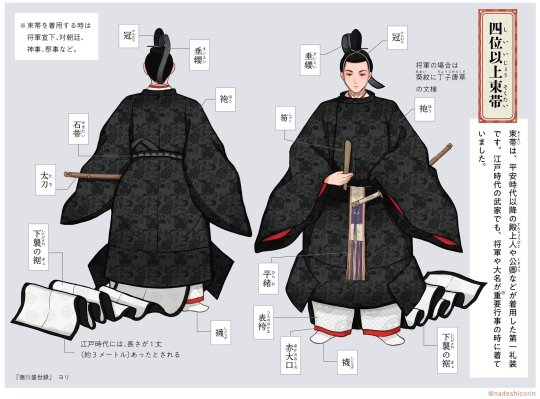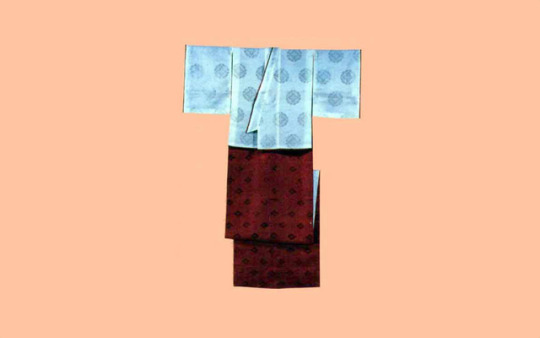#Shitagasane
Text
Most formal outfits for upper ranks samurai - Sokutai and Ikan formal court dress
(as worn by upper-ranked samurai of the Edo period - great charts by Nadeshico Rin). You can find more about samurai ranks and their regulated attires under the tag "samurai kimono".
The Sokutai

束帯 Sokutai is the most formal attire worn by Edo period samurai of the 4th rank and above.
It first appeared during Heian era as a ceremonial court dress worn by 公卿 kuge (nobility/Imperial court) and 殿上人tenjôbito (courtiers/court officials). Usage was kept well into Edo period by both the Imperial court and the Tokugawa shogunate.
The intricated garb includes:
冠 Kanmuri - hat, with distinctive 垂纓 suiei "tail" hanging in the back. Materials could include silk, lacquer or horsehair and were strickly regulated
袍 Hô - a round-necked robe with large boxy sleeves. Colors and patterns were strickly regulated.
Shown here is a pattern used by the Shôgun, the 葵に丁子唐草 Aoi ni chôji karakusa (cloves with arabesques, and hollyhock leaves - which is the Tokugawa crest)
笏 Shaku - flat ritual sceptre
平緒 Hirao - a wide flat braid wrapped around the body with ties left hanging up front. Colors and weaves were strickly regulated
(飾)太刀 (Kazari)-Tachi - (mock) long sword for ceremonial use
表袴 Ue-no-bakama (or omote-bakama) - white overpants, shorter hakama pants worn over the aka-ôkuchi
赤大口(袴) Aka-ôkuchi(bakama) - red underpants, a tad longer than the overpants
下襲(の裾) Shitagasane(no-kyo) - visible train part of an inner robe worn under the 袍 hô. During Edo period, train lenght got up to 1丈 (around 3 meters/10 feet).
襪 Shitôzu - a type of ancient socks (construction is different than tabi - they don't have a sole for ex.)
石帯 Sekitai - leather belt used in ceremonial court dress, covered in black lacquer, and decorated with stones and jewels
The Ikan

衣冠 Ikan - while still very formal and worn by Edo period samurai of the 4th rank and above, ikan looked much more simpler than sokutai.
First used for nightime duties (夜間宿直) in Heian era, it gradually came to be worm during daytime too. From Muromachi period and onwards, it had become the work uniform of the Imperial court.
Like sokutai, it uses the hô+kanmuri, and wearers were allowed to carry kazari-tachi. Yet, note how the pants differ from sokutai ones: those are large bouffant pants called 指貫 sashinuki (or 奴袴 nubakama).
You can also note that wearer here is not holding a shaku scepter: it's a folded 檜扇 hiôgi (formal folding fan made of cypress also of Heian history. Those were unpatterned as painted ones were for women).
#japan#fashion#fashion history#nadeshico rin#samurai kimono#samurai#buke#warrior class#sokutai#ikan#edo period#edo era#heian period#reference#ressources#men kimono#着物#Kanmuri#Hou#Shaku#Hirao#Tachi#Ue-no-bakama#omote-bakama#Aka-ôkuchi#Shitagasane#Shitôzu#Sekitai#Ikan#sashinuki
279 notes
·
View notes
Photo



Koikishu’s Fantasy Kimono Tansu: Furisode/ Chuufurisode
Motifs: Peony, Chrysanthemum, Camelia, Fern, Folding Fans
Seasonality: Season-less
Sleeve Length: 91 cm
Background Color: off-White
Source: https://www.ichiroya.com/item/list2/477457/
34 notes
·
View notes
Photo

shitagasane
http://www.sengokudaimyo.com/garb/garb.ch01.html
0 notes
Photo

[Adzusai], snake god dancing to purify the earth, eerie art by @tanaikeya13
This painting is very well thought: masked dancer’s attire is both a nod to kagura sacred dances (see the special bells below), and a wink to snake gods (from the mask to the scaly frills up front).

Snakes are deeply linked to water bodies, be it river or rain. Here, the shitagasane coiling train has hydrangeas motifs (ajisai, formerly written adzusai), a water loving flower symbol of tsuyu, Japan’s rainy season.
#japan#art#snake#hebi#white snake#shinto#kagura#kagura suzu#shitagasane#japanese dance#paper umbrella#kasa#rain#tsuyu
285 notes
·
View notes